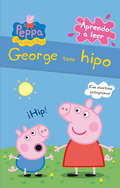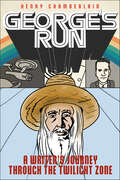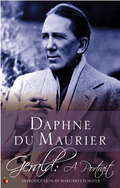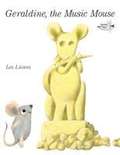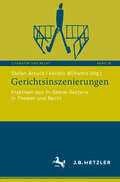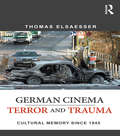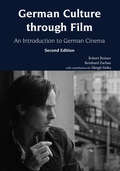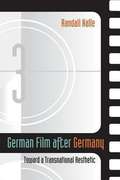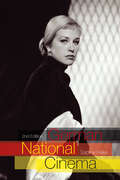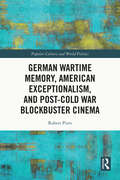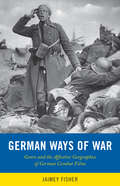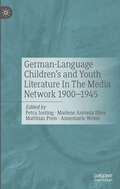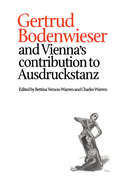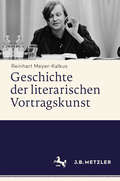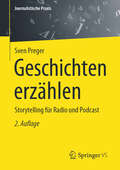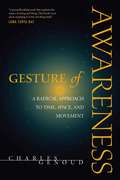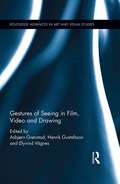- Table View
- List View
George tiene hipo (Peppa Pig. Pictogramas)
by Varios AutoresPeppa y George tienen muchas ganas de salir a jugar al jardín. Así que desayunan tan rápido que a George le entra hipo. Descubre cómo Peppa consigue que se le pase.
George's Run: A Writer's Journey through the Twilight Zone
by Henry ChamberlainGeorge Clayton Johnson was an up-and-coming short story writer who broke into Hollywood in a big way when he co-wrote the screenplay for Ocean’s Eleven. More legendary works followed, including Logan’s Run and classic scripts for shows like The Twilight Zone and Star Trek. In the meantime, he forged friendships with some of the era’s most visionary science fiction writers, including Ray Bradbury, Theodore Sturgeon, Richard Matheson, and Rod Serling. Later in life, Johnson befriended comics journalist and artist Henry Chamberlain, and the two had long chats about his amazing life and career. Now Chamberlain pays tribute to his late friend in the graphic novel George’s Run, which brings Johnson’s creative milieu to life in vividly illustrated color panels. The result feels less like reading a conventional biography and more like sitting in on an intimate conversation between friends as they recollect key moments in pop culture history, as well as the colorful band of writers known as the “Rat Pack of Science Fiction.”
Georgia Music
by Helen V. GriffithA little girl and her grandfather share two different kinds of music, that of his mouth organ and that of the birds and insects around his cabin.
Gerald: A Portrait
by Daphne Du Maurier"A remarkable book...brilliant comic writing." --The Times (UK) Sir Gerald du Maurier was the preeminent actor-manager of his day, knighted in 1922 for his services to the theater. Published within six months of her father's death, Daphne du Maurier's frank portrait was considered shocking by many of his admirers-but it was a huge success, winning her critical acclaim and launching her career. Here, Daphne captures the spirit and charm of the charismatic actor who played the original Captain Hook, amusingly recounting his eccentricities, his humor, as well as his darker side.
Gerald: A Portrait (Virago Modern Classics #113)
by Daphne Du MaurierFROM THE BESTSELLING AUTHOR OF REBECCASir Gerald du Maurier was the most celebrated actor-manager of his day, knighted for his services to the theatre in 1922, and the father to one of the most enduring writers of the twentieth century. Published within six months of her father's death, this frank biography was considered shocking by many of his admirers - but it was a huge success, winning Daphne du Maurier critical acclaim and launching her career.In Gerald: A Portrait, Daphne du Maurier captures the spirit and charm of the charismatic actor who played the original Captain Hook, amusingly recalling his eccentricities and his sense of humour, and sensitively portraying the darker side of his nature and his bouts of depression.A remarkable book . . . brilliant comic writing - The Times
Gerald: A Portrait (Vmc Ser. #654)
by Daphne Du MaurierFROM THE BESTSELLING AUTHOR OF REBECCASir Gerald du Maurier was the most celebrated actor-manager of his day, knighted for his services to the theatre in 1922, and the father to one of the most enduring writers of the twentieth century. Published within six months of her father's death, this frank biography was considered shocking by many of his admirers - but it was a huge success, winning Daphne du Maurier critical acclaim and launching her career.In Gerald: A Portrait, Daphne du Maurier captures the spirit and charm of the charismatic actor who played the original Captain Hook, amusingly recalling his eccentricities and his sense of humour, and sensitively portraying the darker side of his nature and his bouts of depression.A remarkable book . . . brilliant comic writing - The Times
Geraldine, The Music Mouse
by Leo LionniThe cheerful celebration of art, music, and cheese from beloved four-time Caldecott Honor-winner Leo Lionni. <P><P>While nibbling at a huge hunk of parmesan cheese, Geraldine uncovers a cheese statue of a mouse playing what seems to be a flute but on closer inspection is really its tail. That night Geraldine is woken by silver and gold sounds. “This must be music!” she says. And every night the cheese mouse fills Geraldine’s hideaway with beautiful music. Then one day her hungry mice friends ask her to share her cheese with them. Geraldine’s new love of music infuses her with a magic of her own and provides a satisfying conclusion to this delightful tale. <P><P>Lexile Measure: 0630
Gerhard Hauptmann and the Naturalist Drama
by John OsborneWhat was German Naturalism? What were its achievements? How does it compare with its counterparts in other European countries? These are some of the difficult questions addressed by John Osborne in Gerhart Hauptmann and the Naturalist Drama, a revised and updated version of his The Naturalist Drama in Germany, now widely acknowledged as the standard introduction to the subject. The debates to which he contributed, and in some cases initiated, on Naturalism in the German theatre, Naturalist theory in Germany, and the development of the Naturalist movement to the contemporary Social Democrat movement, have remained central issues. This revised edition preserves the structure and approach of the original, including its emphasis on the early dramas of Hauptmann, while taking full account of subsequent scholarship which provides the context in which this Naturalist playwright's work can be placed.
Gerichtsinszenierungen: Praktiken des In-Szene-Setzens in Theater und Recht (Literatur und Recht #18)
by Stefan Arnold Kerstin WilhelmsDie Beiträge des Bandes gehen der These nach, dass in Gerichtsprozessen sowie in theatralen Gerichtsperformances Inszenierungspraktiken am Werk sind, deren Untersuchung zeigt, wie sich die sozialen Felder Recht und Theater gegenseitig konstituieren. Die rechtswissenschaftlichen Beiträge untersuchen, wie theatrale Praktiken des Inszenierens Gerichtsprozesse strukturieren und bedeutsam machen. Die literaturwissenschaftlichen Beiträge untersuchen theatrale Inszenierungen von Gerichtsprozessen als (politische) Kommentierung realer Verfahren bzw. als metareflexive Verhandlung sozialer Praktiken im Gerichtsverfahren.
Germaine Dulac: A Cinema of Sensations
by Tami WilliamsBest known for directing the Impressionist classic The Smiling Madame Beudet and the first Surrealist film The Seashell and the Clergyman, Germaine Dulac, feminist and pioneer of 1920s French avant-garde cinema, made close to thirty fiction films as well as numerous documentaries and newsreels. Through her filmmaking, writing, and cine-club activism, Dulac's passionate defense of the cinema as a lyrical art and social practice had a major influence on twentieth century film history and theory. In Germaine Dulac: A Cinema of Sensations, Tami Williams makes unprecedented use of the filmmaker's personal papers, production files, and archival film prints to produce the first full-length historical study and critical biography of Dulac. Williams's analysis explores the artistic and sociopolitical currents that shaped Dulac's approach to cinema while interrogating the ground breaking techniques and strategies she used to critique conservative notions of gender and sexuality. Moving beyond the director's work of the 1920s, Williams examines Dulac's largely ignored 1930s documentaries and newsreels establishing clear links with the more experimental impressionist and abstract works of her early period. This vivid portrait will be of interest to general readers, as well as to scholars of cinema and visual culture, performance, French history, women's studies, queer cinema, in addition to studies of narrative avant-garde, experimental, and documentary film history and theory.
German Cinema - Terror and Trauma: Cultural Memory Since 1945
by Thomas ElsaesserIn German Cinema – Terror and Trauma Since 1945, Thomas Elsaesser reevaluates the meaning of the Holocaust for postwar German films and culture, while offering a reconsideration of trauma theory today. Elsaesser argues that Germany's attempts at "mastering the past" can be seen as both a failure and an achievement, making it appropriate to speak of an ongoing 'guilt management' that includes not only Germany, but Europe as a whole. In a series of case studies, which consider the work of Konrad Wolf, Alexander Kluge, Rainer Werner Fassbinder, Herbert Achterbusch and Harun Farocki, as well as films made in the new century, Elsaesser tracks the different ways the Holocaust is present in German cinema from the 1950s onwards, even when it is absent, or referenced in oblique and hyperbolic ways. Its most emphatically "absent presence" might turn out to be the compulsive afterlife of the Red Army Faction, whose acts of terror in the 1970s were a response to—as well as a reminder of—Nazism’s hold on the national imaginary. Since the end of the Cold War and 9/11, the terms of the debate around terror and trauma have shifted also in Germany, where generational memory now distributes the roles of historical agency and accountability differently. Against the background of universalized victimhood, a cinema of commemoration has, if anything, confirmed the violence that the past continues to exert on the present, in the form of missed encounters, retroactive incidents, unintended slippages and uncanny parallels, which Elsaesser—reviving the full meaning of Freud’s Fehlleistung—calls the parapractic performativity of cultural memory.
German Cinema in the Age of Neoliberalism (Film Culture in Transition)
by Hester BaerThis book presents a new history of German film from 1980-2010, a period that witnessed rapid transformations, including intensified globalization, a restructured world economy, geopolitical realignment, and technological change, all of which have affected cinema in fundamental ways. Rethinking the conventional periodization of German film history, Baer posits 1980-rather than 1989-as a crucial turning point for German cinema's embrace of a new market orientation and move away from the state-sponsored film culture that characterized both DEFA and the New German Cinema. Reading films from East, West, and post-unification Germany together, Baer argues that contemporary German cinema is characterized most strongly by its origins in and responses to advanced capitalism. Informed by a feminist approach and in dialogue with prominent theories of contemporary film, the book places a special focus on how German films make visible the neoliberal recasting of gender and national identities around the new millennium.
German Culture through Film: An Introduction to German Cinema
by Robert C. Reimer Reinhard Zachau Margit M. SinkaGerman Culture through Film: An Introduction to German Cinema is an English-language text that serves equally well in courses on modern German film, in courses on general film studies, in courses that incorporate film as a way to study culture, and as an engaging resource for scholars, students, and devotees of cinema and film history. In its second edition, German Culture through Film expands on the first edition, providing additional chapters with context for understanding the era in which the featured films were produced. Thirty-three notable German films are arranged in seven chronological chapters, spanning key moments in German film history, from the silent era to the present. Each chapter begins with an introduction that focuses on the history and culture surrounding films of the relevant period. Sections within chapters are each devoted to one particular film, providing film credits, a summary of the story, background information, an evaluation, questions and activities to encourage diverse interpretations, a list of related films, and bibliographical information on the films discussed.
German Film after Germany: Toward a Transnational Aesthetic
by Randall HalleWhat is the work of film in the age of transnational production? To answer that question, Randall Halle focuses on the film industry of Germany, one of Europe's largest film markets and one of the world's largest film-producing nations. In the 1990s Germany experienced an extreme transition from a state-subsidized mode of film production that was free of anxious concerns about profit and audience entertainment to a mode dominated by private interest and big capital. At the same time, the European Union began actively drawing together the national markets of Germany and other European nations, sublating their individual significances into a synergistic whole. This book studies these changes broadly, but also focuses on the transformations in their particular national context. It balances film politics and film aesthetics, tracing transformations in financing along with analyses of particular films to describe the effects on the film object itself. Halle concludes that we witness currently the emergence of a new transnational aesthetic, a fundamental shift in cultural production with ramifications for communal identifications, state cohesion, and national economies.
German National Cinema (National Cinemas)
by Sabine HakeGerman National Cinema is the first comprehensive history of German film from its origins to the present. In this new edition, Sabine Hake discusses film-making in economic, political, social, and cultural terms, and considers the contribution of Germany's most popular films to changing definitions of genre, authorship, and film form. The book traces the central role of cinema in the nation’s turbulent history from the Wilhelmine Empire to the Berlin Republic, with special attention paid to the competing demands of film as art, entertainment, and propaganda. Hake also explores the centrality of genre films and the star system to the development of a filmic imaginary. This fully revised and updated new edition will be required reading for everyone interested in German film and the history of modern Germany.
German Wartime Memory, American Exceptionalism, and Post-Cold War Blockbuster Cinema (Popular Culture and World Politics)
by Robert PirroThis book excavates the diverse and mostly unnoticed political meanings made available to American and German audiences by the blockbuster films helmed by transplanted West German directors Roland Emmerich and Wolfgang Petersen.Through formal film analysis, broad consideration of American and German film criticism, and reflection on relevant political developments of the post-Cold War era, the book reveals how traces of Germany’s experience of dictatorship and wartime destruction find inadvertent cinematic expression in ways that helped American and German moviegoers find orientation in the changed political and cultural landscape of a newly globalized world. To complement and deepen the analysis of the Hollywood output of Emmerich and Petersen, the book juxtaposes the creative product of these transplanted directors to examples of a converse cinematic phenomenon considered under the label, American Babelsberg, which encompasses World War Two-themed films shot by American directors in Germany utilizing the production facilities at Babelsberg. Focus here is placed particularly on two high-profile cinematic releases of the aughts, Valkyrie (2008), and Inglourious Basterds (2009). The magnetic attraction to, or nettlesome burden of, World War Two memories on these directors of American Babelsberg and German Hollywood is explained in this book by the entwined histories of Germans and Americans, the different challenges of national self-definition and renewal they faced in the post-Cold War world, and their long-standing and ongoing transatlantic discourse of political ideas and cultural ideals.This book will be of great interest to students and scholars of film studies, politics, popular culture, and contemporary history.
German Ways of War: The Affective Geographies and Generic Transformations of German War Films (War Culture)
by Jaimey FisherGerman Ways of War deploys theories of space, mobility, and affect to investigate how war films realize their political projects. Analyzing films across the decades, from the 1910s to 2000s, German Ways of War addresses an important lacuna in media studies: while scholars have tended to focus on the similarities between cinematic looking and weaponized targeting -- between shooting a camera and discharging a gun – this book argues that war films negotiate spaces throughout that frame their violence in ways more revealing than their battle scenes. Beyond that well-known intersection of visuality and violence, German Ways of War explores how the genre frames violence within spatio-affective operations. The production of novel spaces and evocation of new affects transform war films, including the genre’s manipulation of mobility, landscape, territory, scales, and topological networks. Such effects amount to what author Jaimey Fisher terms the films’ “affective geographies” that interweave narrative-generated affects, spatial depictions, and political processes.
German-Language Children's and Youth Literature In The Media Network 1900-1945.
by Petra Josting Marlene Antonia Illies Matthias Preis Annemarie WeberWith the research of German-language children's and youth literature and its media associations in the period from 1900 to 1945 as well as the recording of all data in an online portal for research and visual analysis, an innovative contribution to the historiography of children's and youth literature is available. The introduction provides information on the criteria for inclusion, central sources, theoretical frameworks, and the spectrum of the media associations investigated. Part I assembles three overview articles on the media of radio, film and theater for children and young people as well as a contribution on the conception and development of the online portal. In the second part, 18 selected media alliances are presented, sorted into the categories pioneers conquer the new media - stage children migrate to radio and/or film - fairy tales in film and radio - classics in all media - school stories in the theater, book and on the screen - crime and scandal on the screen - political conquers book and film.
Gertrud Bodenwieser and Vienna's Contribution to Ausdruckstanz (Choreography and Dance Studies Series #18)
by Charles Warren Bettina Vernon-WarrenFirst Published in 1999. Routledge is an imprint of Taylor & Francis, an informa company.
Geschichte der Intervision: Der transnationale Fernsehprogrammaustausch in Osteuropa 1960–1993 (Film, Fernsehen, Medienkultur)
by Yulia Yurtaeva-MartensDie Immanenz des internationalen Programmaustausches im Medium Fernsehen aufzuzeigen, ist das zentrale Anliegen dieses Bandes. Die Studie legt eine systematische Analyse der Entstehung, Entwicklung und Tätigkeit der Intervision vor, einer osteuropäischen – und aus heutiger Sicht transnationalen – Organisation, die 1960 zur Koordinierung des Fernsehprogrammaustausches ins Leben gerufen wurde. Den Schwerpunkt der Arbeit bildet die qualitative und quantitative Auswertung des Programmaustausches innerhalb der Intervision sowie deren Zusammenarbeit mit der westeuropäischen Eurovision unter Berücksichtigung der damaligen politischen und technologischen Rahmenbedingungen und Implikationen. Die analytische Betrachtung erstreckt sich dabei auf den gesamten Zeitraum des Bestehens der Intervision von 1960 bis 1993. Mit dieser umfassenden Untersuchung liefert der Band wertvolle Einblicke in die Mechanismen und Dynamiken des europäischen Fernsehprogrammaustausches in den Zeiten des Kalten Krieges und schließt an die gegenwärtige Forschung zum sozialistischen Fernsehen aus transnationaler Perspektive an.
Geschichte der literarischen Vortragskunst
by Reinhart Meyer-KalkusLiterarische Vortragskunst entstand in Deutschland in der zweiten Hälfte des 18. Jahrhunderts als ein von Schauspiel und anderen Vortragsgattungen (Rede, Predigt, Vorlesung etc.) unterschiedenes Sprachspiel des Vorlesens, Rezitierens und Deklamierens von Gedichten, Erzählungen und Dramen. Die vorliegende Untersuchung ist die erste umfassende Geschichte dieser Vortragskunst von Klopstock bis zu Kling, ja bis zum Poetry-Slam. Sie konzentriert sich auf die verschiedenen Akteure (Autoren, professionelle Rezitatoren, Deutschlehrer, Sprecherzieher und Laien) sowie auf deren Vortragsformate und Zuhörer im Kontext der Veränderung vortragsästhetischer Normen und mediengeschichtlicher Innovationen. Mit Rückgriff auf Einsichten der Medienwissenschaft, Performance-Analyse und Stimmforschung entwickelt sie einen analytischen Ansatz, um Vortragsformate und Vortragsweisen in ihrer Historizität zu beschreiben.
Geschichten erzählen: Storytelling für Radio und Podcast (Journalistische Praxis)
by Sven PregerEs gehört zu den schönsten und komplexesten Aufgaben in Podcast und Radio: spannende Geschichten zu erzählen. Wie kann ich Hörer*innen 15, 30 oder 60 Minuten an eine reale Geschichte binden? Oder gar für eine ganze Serie begeistern? Dieses Buch beschreibt den professionellen Weg zu einer spannenden Erzählung. Es gibt praxistaugliche Antworten auf alle entscheidenden Fragen: Welche Stoffe taugen für lange Geschichten? Wie halte ich die Spannung von Anfang bis Ende aufrecht? Wie finde ich meine Erzählstimme und klinge als Host natürlich? Und wie entwickelt man ein Sound Design für komplexe Erzählungen? Ein Praxis-Buch, mit dessen Hilfe sich die Potenziale von Podcast und Radio entfalten lassen. Die Website zum Buch bietet weiterführende Links und ergänzt aktuelle Entwicklungen. Für die zweite Auflage wurde der Band überarbeitet, aktualisiert und mit neuen Beispielen ergänzt.
Gesture of Awareness: A Radical Approach to Time, Space, and Movement
by Charles GenoudFrom a major mind of Buddhism today comes this unique philosophical work, which hearkens back to the classical verse-form, but in a modern voice that speaks directly to the twenty-first century reader and practitioner. Gesture of Awareness involves a fascinating philosophical exploration of time, space, and movement but at the same time is a manual for an embodied "practice of exploration." Genoud is very well known to the leading lights of Buddhism today. He and his work are continuingly praised for their invention and importance. Well-versed in French and continental philosophies, as well as Eastern thought, he has produced a work that will be welcomed as a Buddhist book and a noteworthy contribution to the larger philosophical community.
Gestures of Love: Romancing Performance in Classical Hollywood Cinema (SUNY series, Horizons of Cinema)
by Steven RybinGestures of Love considers the viewer's enchantment with charismatic actors in film as the starting point for closely analyzing the performance of love in movies. Written with a thoughtful adoration for the actors who move us, Steven Rybin examines several of cinema's most beloved on-screen movie couples, including Katharine Hepburn and Cary Grant, Myrna Loy and William Powell, Carole Lombard and John Barrymore, Gene Tierney and Dana Andrews, Lauren Bacall and Humphrey Bogart, and Rock Hudson and Dorothy Malone. Using the classical genres of screwball comedy, film noir, and the family melodrama as touchstones, Rybin places the depiction of romance in films into dialogue with the viewer's own emotional bond to the actors on the screen. In doing so, he offers rich new analyses of such classic films as Bringing Up Baby, The Thin Man, Twentieth Century, Laura, To Have and Have Not, Tea and Sympathy, Written on the Wind, and more.
Gestures of Seeing in Film, Video and Drawing (Routledge Advances in Art and Visual Studies)
by Øyvind Vågnes Asbjørn Grønstad Henrik GustafssonThe first book of its kind, Gestures of Seeing in Film, Video and Drawing engages broadly with the often too neglected yet significant questions of gesture in visual culture. In our turbulent mediasphere where images – as lenses bearing on their own circumstances – are constantly mobilized to enact symbolic forms of warfare and where they get entangled in all kinds of cultural conflicts and controversies, a turn to the gestural life of images seems to promise a particularly pertinent avenue of intellectual inquiry. The complex gestures of the artwork remain an under-explored theoretical topos in contemporary visual culture studies. In visual art, the gestural appears to be that which intervenes between form and content, materiality and meaning. But as a conceptual force it also impinges upon the very process of seeing itself. As a critical and heuristic trope, the gestural galvanizes many of the most pertinent areas of inquiry in contemporary debates and scholarship in visual culture and related disciplines: ethics (images and their values and affects), aesthetics (from visual essentialism to transesthetics and synesthesia), ecology (iconoclastic gestures and spaces of conflict), and epistemology (questions of the archive, memory and documentation). Offering fresh perspectives on many of these areas, Gestures of Seeing in Film, Video and Drawing will be intensely awaited by readers from and across several disciplines, such as anthropology, linguistics, performance, theater, film and visual studies.
